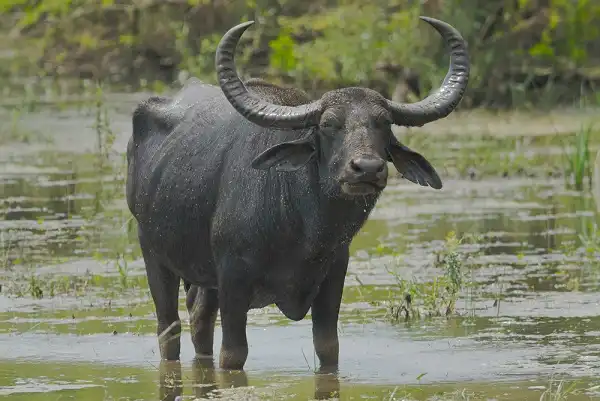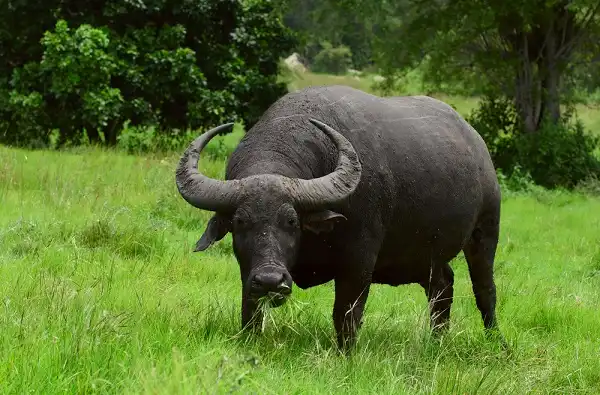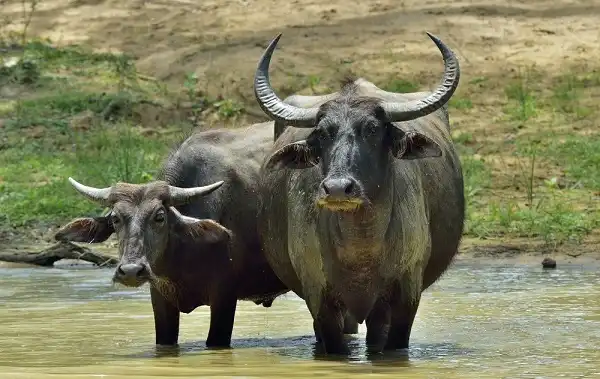When it comes to iconic animals of the world, water buffalos oftentimes don’t make the list. But these hardy animals should not be overlooked – they are powerful, gentle giants that have been used by humans for centuries! With their intimidating horns and distinctive features, these creatures are fascinating and very important in cultures around the world. In this blog post, we will dive into some interesting facts about water buffalos – their anatomy and behavior, how they interact with people, and their role in agriculture, and the environment – to give readers a better understanding of both this intriguing animal but also our relationship with them.

Water Buffalo Description
Water buffalos, also known as Bubalus bubalis, are large, bovine animals. These majestic creatures possess a distinctive appearance that sets them apart from other bovines, including their large, curved horns that can measure up to five feet in length! Their unique horns, coupled with their massive size and imposing presence, make them a truly awe-inspiring sight to behold. Water buffalos are known for their tough and sturdy body structures, which make them well-suited for a variety of agricultural purposes. They have broad, muscular shoulders and torsos that taper down to powerful, wide hindquarters. Their thick, dark coats are water-resistant and help keep them warm in cold temperatures.
Water Buffalo Habitat
Water buffalos are adaptable creatures that can thrive in a variety of environments. They are native to Asia, Africa, and Europe, but have also been introduced to other parts of the world, such as Australia and North America. However, they are most commonly found in wetlands, marshes, and swamps, where they have easy access to water and food. In their natural habitats, water buffalos play an important role in the ecosystem. They help to maintain the balance of wetland and grassland ecosystems, where they graze on vegetation and help to keep the grasses from becoming too overgrown. This, in turn, benefits other animal species that depend on these ecosystems for survival.
Water buffalos also have a remarkable ability to adapt to extreme environments. They can survive in areas with high temperatures, as well as in areas with cold temperatures and heavy snow. Their thick coats help to keep them warm in cold weather, while their ability to submerge themselves in water helps them to cool off in hot weather. Efforts are being made to protect water buffalo habitats and increase their numbers through conservation programs. These programs aim to create protected areas for the animals to live in, as well as to educate people about the importance of preserving wetland ecosystems. Through these efforts, we can hope to ensure that these magnificent creatures continue to thrive in the wild.
Water Buffalo Diet
Water buffalos are herbivores that consume a wide range of vegetation, including grasses, leaves, and reeds. Their voracious appetite allows them to consume up to 50 pounds of food per day, making them one of the largest herbivores in the animal kingdom. They use their powerful jaws to break down tough vegetation and their four-chambered stomachs to fully digest their food. Due to their natural habitat in wetlands and grasslands, water buffalos have adapted to consume both terrestrial and aquatic plants. They can consume submerged aquatic vegetation, which provides them with essential nutrients, especially during the dry season when other vegetation is scarce. In addition, their diet is rich in carbohydrates and fiber, which enables them to sustain their massive size and strength. These nutrients also enable them to undertake arduous farm work, such as plowing fields and hauling heavy loads.

Water Buffalo Size
Water buffalos are among the largest herbivores in the animal kingdom, with their size varying depending on their subspecies and sex. Adult water buffalos typically weigh between 700 to 2,650 pounds, with males being larger than females. They can grow up to 6.6 feet tall at the shoulder and 11.5 feet long, from head to tail. Their massive size is accompanied by solid, muscular bodies equipped with powerful limbs and hooves. Their large and sturdy bodies make them perfectly suited for their traditional roles of farm work, such as plowing fields and carrying heavy loads.
Water buffalo calves are born weighing between 55 to 99 pounds, and they rely on their mothers’ milk for sustenance until they are weaned at six to eight months old. After weaning, they start to graze on vegetation and can grow up to 1.5 pounds per day. Apart from their size, water buffalos have other distinctive physical features that make them easy to identify. One such feature is their curved, thick horns that grow up to 5 feet long. Both males and females have horns, and they use them for defense against predators and competing males.
Water Buffalo Lifespan
The lifespan of water buffalos varies depending on factors such as their environment, subspecies, and genetics. However, on average, they can live up to 20-25 years in the wild and up to 25-30 years in captivity. Several factors impact the lifespan of water buffalos, including food availability, disease, predator encounters, and human activities such as hunting or poaching. Habitat loss and degradation also pose significant threats to the survival of these magnificent animals, thereby reducing their lifespan considerably. Despite their imposing size and strength, water buffalos are surprisingly vulnerable to diseases such as foot and mouth disease, tuberculosis, and liver flukes, which can significantly reduce their lifespan. Adequate measures such as vaccinations and preventive treatments can help reduce the incidence of diseases and promote longevity. Efforts are being made worldwide to conserve and protect water buffalos and their habitats through various conservation programs and initiatives. By creating awareness and taking steps to minimize human-wildlife conflict, we can hope to create an environment that promotes the healthy and prolonged lifespan of these magnificent creatures.
Water Buffalo Behavior
Water buffalos are social animals that prefer to live in family groups, consisting of adult females and their offspring. Males usually live solitary lives, only joining female groups during mating season. These intelligent animals communicate using a variety of vocalizations, body language, and scent markings. Water buffalos are mainly active during the daytime, spending most of their time grazing on vegetation, which makes up the majority of their diet. They are excellent swimmers and can often be found wallowing in muddy water, which helps them to cool off in hot weather and also serves as a method of getting rid of parasites on their skin. The bond between mother and calf is particularly strong in water buffalos, with mothers being very protective of their young. Calves stay close to their mothers for the first few months of their lives, and this close relationship helps the calf learn to communicate and survive in its environment. While they are generally calm animals, males can become aggressive during mating season, engaging in battles for dominance.

Water Buffalo Speed
Water buffalos are not the fastest animals on land, but they are capable of running up to speeds of 30 miles per hour (48 kilometers per hour). However, their primary method of defense against predators is not speed but their imposing size and muscular physique, which makes them formidable prey. Their bulk and strength also enable them to undertake strenuous tasks, such as plowing fields and carrying heavy loads. Water buffalos have a unique gait, which involves moving both legs on one side of their body at the same time, followed by the legs on the other side. This method of walking creates a swaying motion, which helps distribute their weight evenly and reduces the strain on their legs and joints. Despite their impressive size and strength, water buffalos are also known for their docile and easy-going nature, making them ideal working animals. They are used extensively in agriculture for tasks such as plowing, hauling carts, and transporting goods. In terms of swimming, water buffalos are excellent and can cross rivers, lakes, and other bodies of water with ease. They are often seen wallowing in muddy water to cool off on hot days, which also serves as a method of getting rid of parasites on their skin.
Water Buffalo Hunting
Water buffalo hunting has been a longstanding tradition in some parts of the world, but it has also contributed to the decline of their populations. In some countries, water buffalo hunting is illegal, but in others, it is still permitted through regulated hunting programs. Hunters usually target male water buffalos, as they are solitary animals during most of the year and are more likely to roam alone. These animals can provide a significant challenge to hunters due to their size, strength, and aggressive nature during their mating season. To hunt water buffalos, hunters typically use high-powered rifles, but some prefer to use bows and arrows or even spears for a more traditional approach. While water buffalo hunting can be an exhilarating experience, it is also a controversial one. The decline of water buffalo populations through hunting and habitat loss has become a global concern, and many conservationists have made efforts to conserve and protect these magnificent creatures. In recent years, the trend has been towards eco-tourism, where tourists can observe these animals in their natural habitats without causing harm or disruption to their way of life.

Conclusion
Water buffalos are incredible animals, with impressive size and strength that make them formidable contenders against predators. Furthermore, they possess unique gaits and swimming abilities that make them fascinating creatures to observe in their natural habitats. Despite the longstanding tradition of water buffalo hunting, we must be mindful of sustainable conservation practices to ensure their survival for future generations. By doing so, we can not only appreciate the beauty and majesty of these animals but also have a better chance of ensuring their survival in the wild.
Frequently Asked Question

